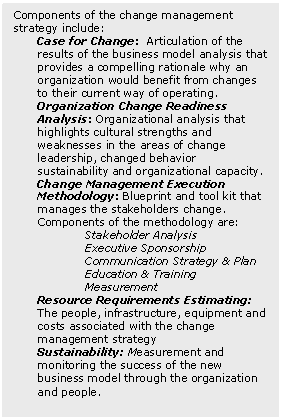| Contact Us |
|
People & Performance Solutions™ and a Pharmaceutical Company Team to Integrate Organizational Change CapabilityDownload a PDF of the Global Pharmaceutical Company success story.Executive Summary People & Performance Solutions worked with a global pharmaceutical company to manage change by integrating a change management strategy with a global business model redesign. The Challenge To maintain its leadership position in the industry, a global pharmaceutical company needed to decide to continue with their current course of action or to change. To be successful, the company needed to do at least one of the following: quickly discover blockbuster drugs; lower costs; and/or increase returns. With the many mergers and acquisitions in the pharmaceutical industry and the lack of any blockbuster drugs entering the market, this pharmaceutical company was facing a dilemma. Thus the company had three options – merge, be acquired or change. Each option required a significant amount of change with some similar yet some very different challenges and risks. Based on the diversity of processes and technology for this pharmaceutical company, to merge or be acquired would be a bigger challenge than to internally consolidate and join process and technology operations. Analyzing the Challenge Therefore the best option for the pharmaceutical company was for them to radically change and operate differently. To initiate the change, the company used an organizational performance model to develop their new business model. The model addressed the following areas:
Due to the enormous amount of global organizational change that was required to ensure success, the pharmaceutical company sought out help with People & Performance Solutions, a change management organization. The Solution People & Performance Solutions was engaged to ensure the pharmaceutical company’s process and technology changes were beneficial and not hindered by their people not being prepared for the change. In order to get the people ready for the change, People & Performance Solutions designed a change management strategy that was integrated into the business process and technology strategy.
Case For Change Since the change was monumental, the Case for Change (see sidebar) was a critical deliverable for the change management team to explain to the rest of the organization why the change was needed. In the Case for Change, the new business model was articulated with compelling rationale with the business benefits to demonstrate the need for a new operating model. There were a number of benefits that were derived from developing a consistent message for the Case for Change, including:
Additionally, the Case for Change was flexible that allowed usability for many audiences; executives, managers, board members, customers and vendors.
Organization Change Readiness Analysis In order to move ahead, it was critical that People & Performance Solutions identify the company’s organization readiness to change and to determine how the change within the company needed to be managed. This analysis highlighted cultural strengths and weaknesses in change leadership, changed behavior sustainability and organizational capacity that includes; assessing the company’s experience, skills and abilities with change. A three point scale was developed to assess the company from least to most challenging change characteristic. People & Performance Solution assessed the following areas:
Due to the fact that the new business model would require employees to work differently and for the emphasis on speed of delivery, it was critical that the company overcome historical change barriers. The output of the analysis helped the change management team to identify and define solutions to overcome the company’s change readiness challenges. Change Management Execution Methodology and Tools After defining the Case for Change and analyzing the organizations change readiness capabilities, People & Performance Solutions used a systematic change management methodology and tools to develop a comprehensive change management plan. The plan was the blueprint to move the organization from their initial perceptions of the new business model, to manage their reaction, to provide tools and support during the change and to ensure continued success once the new business model was in place. The plan included the following: Stakeholder Analysis - The analysis included the potential stakeholders impacted by the business model change, including third party vendors, suppliers and customers. Each stakeholder group identified were analyzed by what was impacting them, how many people were impacted, the location of the impacted people, as well as additional challenges (language, location, accessibility, subcontractors, etc). Gathering this information at the onset of the project was needed to plan and budget for the remaining change management activities. Executive Sponsorship To carry out a successful change management program, it is pertinent that the executive sponsorship is continued throughout the entire implementation of the new business model. To ensure that the support of executives and management was continuous, the change management team developed a comprehensive executive sponsorship plan outlined with objectives and activities from the project initiation through the operations of the new business model. The plan focused on global, regional and local market leadership/line management engagement, education and preparation of sponsors for the change throughout the lifecycle of the program. The outcome of the Executive Sponsorship was that the executives saw and understood the case for change, bought into the new business model and were committed themselves. The program not only gained commitment and assisted in the management of change with the executives and managers, but it also helped to develop and build their own change management leadership skills for future programs. Communication Strategy and Plan Once the change management plan aligned the company’s people and culture with the changes in the business processes, technology and organization, it was essential to develop a communication plan. The communication plan was created to align the implementation lifecycle of the new business model plan and it was designed to sequential move the stakeholders from a strategic point of view to tactical activities. As part of the communication strategy, People & Performance Solutions defined the objectives and critical success factors of the plan, conducted audience and media analysis, defined the communication process, roles and responsibilities, and defined the communication feedback strategy. The plan defined the following:
The success of the plan depended on aligning communications with the new business objectives focusing on the critical audiences, delivering the information with a clear concise and repeatable message, and a means to gather feedback on the effectiveness of the communication. To ensure this was done effectively and consistently, the change management team became the gatekeeper for communication. Education and Training Based on the stakeholder groups, impacted business processes and technology, People & Performance Solutions conducted a skills and knowledge analysis to determine each stakeholder’s new skills and knowledge requirements. With the stakeholder and change readiness data, the team defined the best method to deploy and deliver the education and training program. To help reduce cost and expenses, the team developed a blended learning strategy that included a combination of traditional classroom training, web-based training and virtual classroom training using asynchronous technology to simulate a classroom online. Unlike the other components of the change management methodology that were implemented earlier in the process, education and training would be deployed closer to the execution of the new business model. However, it was essential that the planning and development was initiated at the project design phase to allow for adequate planning and development of the training materials and content.
Resource Requirements Estimating The final component of the change management strategy was to align all of the planned activities to define resources requirements. Using industry standards and metrics, based on the duration of the project and the activities along with assumptions, People & Performance Solutions developed a total resource requirement for the project. This resource requirement included people (pharmaceutical employees and consultants, both full-time and part-time), materials, travel, equipment and infrastructure. For this project team, three groups of resources were considers: project team members; implementation change agents; and executive sponsors. Sustainability To ensure the success of the program, a process was created to measure and monitor ongoing success of the program. To avoid the lack of project accountability, the change management team’s sustain process was put in place to monitor progress and provide feedback on the change management program post implementation. This sustain process would address any unanticipated impacts, evaluate the effectiveness of the program, and show where improvements could be made in the approach or tool kit. The sustain process would monitor the key activities immediately following, as well as monitor three to six months after implementation to ensure compliance of the new processes and technology. Additional, the process would analyze areas of improvements and to identify change management interventions that could be implemented to address deficient areas. Value Delivered In order for the pharmaceutical company to realize the benefits that would be achieved from their process and technology changes, it was essential that the impacted part of the company, including third parties needed to be prepared for the change. The change management strategy conducted and implemented by People & Performance Solutions effectively minimized the potential risk of the program and the pharmaceutical company from achieving their target business benefits. Summary In summary, the root cause of making any change should be the result of business model analysis. The business model analysis will require some degree of organization change which can be time consuming, disruptive and resource intensive if not managed comprehensively, consistently and systematically. Thus it is the change management strategy developed by People & Performance Solutions that embeds leadership and organizational change capabilities into the business model strategy to ensure that risks associated with the organization and its stakeholder are mitigated. This structure will result in a competitive advantage by enabling strategic decision making flexibility and organizational resiliency.
Contact Us to learn about how People & Performance Solutions can help you with your change management needs. |
| ©2005 People & Performance Solutions, LLC, All Rights Reserved. | Site Map |


 The results of the model indicated significant implications on organization boundaries, management, work practices, organization structures, and collaboration. Additionally, employees would need to adapt to new processes and information gathering techniques/tools, develop new skills, work with different people in new relationships, manage new accountabilities and become accustomed to new performance measures.
The results of the model indicated significant implications on organization boundaries, management, work practices, organization structures, and collaboration. Additionally, employees would need to adapt to new processes and information gathering techniques/tools, develop new skills, work with different people in new relationships, manage new accountabilities and become accustomed to new performance measures.